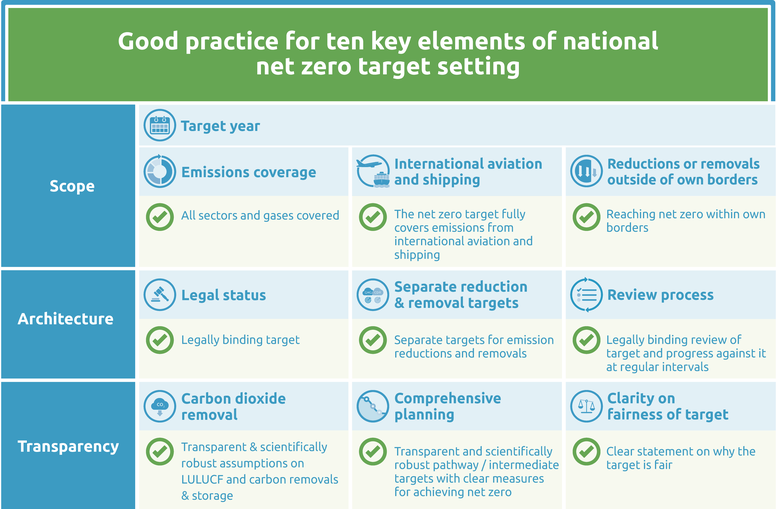Net zero targets
Summary
We evaluate the target as: Poor.
Russia approved its ‘Strategy of socio-economic development of the Russian Federation with low greenhouse gas emissions by 2050’ in October 2021 and submitted it to the UNFCCC on September 5, 2022 as its long-term climate strategy (LTS) (Russian Federation, 2021a, 2022c). As part of this strategy, Russia has committed to reaching net zero greenhouse gas (GHG) emissions by 2060. The strategy also includes a target to reduce GHG emissions by 80% below 1990 levels by 2050, leaning heavily on negative emissions from the LULUCF sector, which are projected to more than double between 2030 and 2050, from -539 MtCO2e to -1,200 MtCO2e.
The Ministry of Economic Development had prepared a draft implementation “road map” for the strategy by February 2022 and planned to finalise it by March (Interfax, 2022; Russian Federation, 2022a). However, as of October 2022 the Ministry is updating the draft to account for “the changed conditions” and “increased challenges” since the implementation plan was first drafted (TASS, 2022).
Some of the key planned measures outlined in the strategy include the creation of economic incentives to reduce GHG emissions, a systematic replacement of inefficient technologies, and creating conditions to ensure Russian companies are competitive in low-carbon markets. At present, there is little to no action being undertaken on any of these stated policy requirements. If Russia is to align itself with the goals of the Paris Agreement, as it has stated it intends to, significant action in these areas and others will be required.
To improve its net zero target rating, the Russian government can consider good practice approaches shown further below including clarifying the reductions and removals projected for its 2060 target in addition to its 2050 target and including international shipping and aviation emissions under the target.
CAT analysis of net zero target
Ten key elements
Scope
- Target year – Russia aims to reach net zero emissions by 2060.
- Emissions coverage – Although the long-term climate strategy does not explicitly list all greenhouse gases covered, the document mentions Russia aims to balance anthropogenic greenhouse gas emissions and sinks by "no later than 2060". Based on this, we interpret the strategy to cover all greenhouse gas emissions. The target covers all sectors of the economy (excluding international aviation and shipping).
- International aviation and shipping – Russia provides no information on its intention to cover international aviation and shipping.
- Reductions or removals outside of own borders – Russia has not provided any information on its intention to use international offset credits to meet its net zero target.
Target architecture
- Legal status – Russia’s ‘Strategy of socio-economic development of the Russian Federation for low greenhouse gas emissions by 2050’, which contains its 2060 net zero target, was approved via government order, akin to legislation, in October 2021 (Russian Federation, 2021a). Russia submitted its Long-Term Strategy to the UNFCCC in September 2022 (Russian Federation, 2022c).
- Separate reduction & removal targets – Separate reduction and removal targets are provided for 2030 and 2050 under Russia’s long-term strategy, but not for its targeted net zero objective in 2060. Planned removals would be as high as half of current emissions of all other sectors, meaning, that these other sectors would only have to be cut in half to meet the net zero target.
- Review process – Russia’s long-term strategy states that progress of its implementation will be monitored, and that the strategy will be updated “as necessary” (Russian Federation, 2022c). The government provides no details on what this means or what such a review would entail. It does refer to the global stocktake mandated under the Paris Agreement in 2023 as a point at which the strategy could be updated.
Transparency
- Carbon dioxide removal – Russia does not provide transparent assumptions on carbon dioxide removal. Russia’s projected negative emissions in 2050 are more than double current levels of land sinks, reaching -1,200 MtCO2e. These negative emissions are projected to be achieved from the LULUCF sector, and there is no information available in the strategy to substantiate the increase or any assumptions on technical carbon dioxide removal approaches. An increase of this magnitude should be transparently explained to justify it as part of the strategy to reach net zero. There is also no projection to 2060 to outline the level of reductions required to reach net zero emissions.
Russia has announced it will update its accounting methodology for estimating emissions from the LULUCF sector, indicating it will begin counting forests currently designated as unmanaged, as managed forest, therefore including them in its GHG inventory (Light, 2021). This is in violation of a key element of international climate reporting, with the UN’s IPCC guidelines stating that only managed forests may be included in carbon accounting practices (IPCC, 2006). - Comprehensive planning – Russia’s long-term emissions strategy outlines several planned measures, but they are lacking detail on how or when they will be implemented, or what their projected impact on emissions would be. The Ministry of Economic Development had finished preparing a draft implementation plan or “road map” in February 2022, however the ministry is now redrafting the implementation plan to take into account the current geopolitical and economic situation (Interfax, 2022; Russian Federation, 2022a; TASS, 2022).
- Clarity on fairness of target – Russia makes no reference to fairness or equity in the context of its net zero target.
For further information on the targets, the Russian Federation has adopted, see the targets tab.
Good practice
The Climate Action Tracker has defined the following good practice for all ten key elements of net zero targets. Countries can refer to this good practice to design or enhance their net zero targets.
Further analysis
Latest publications
Stay informed
Subscribe to our newsletter







